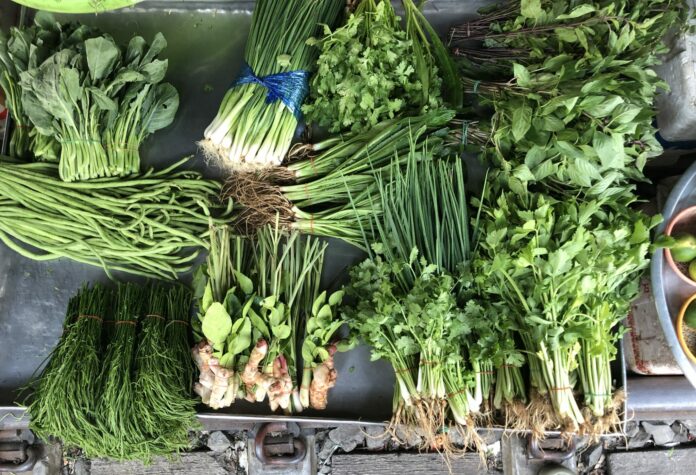What is the meaning of food sovereignty? How can you be a part of the food sovereignty movement? Learn more about his important issue in this practical guide.
Local produce in Kyoto, Japan.
What does food sovereignty mean? The term food sovereignty may be confused with food justice. Food justice has been defined as a holistic and structural view of the food system that sees healthy food as a human right and addresses structural barriers to that right. However, food sovereignty is defined as the right of people to healthy and culturally appropriate food produced through ecologically sound and sustainable methods and the right to define their own food system. While food justice emphasizes the human right to food, food sovereignty encompasses all aspects that are involved with food production, as well as the right to food that is appropriate for each unique individual. Another type of food sovereignty is Indigenous food sovereignty, which is an approach to addressing the underlying issues in Native communities by giving the communities their own control of their food system to be able to respond to their needs for health and choosing culturally appropriate foods. Although these definitions vary a little in meaning, the common theme between food sovereignty and Indigenous food sovereignty is that individuals should have the right and power to obtain culturally appropriate food for his or her lifestyle.
Local foods in Belize.
Principles of Food Sovereignty
Food sovereignty is defined by the following principles, which help ensure that all living individuals have the right to culturally appropriate food, defining their food system, and working in rhythm with nature.
1. Food for the people.
Food for the people highlights peoples’ need for healthy, culturally appropriate food that is the center of food agriculture, livestock, and fishery policies. This principle does not support the corporate regime the food industry has built, nor the health effects of this industrial food system.
Honoring agricultural and traditional foods, such as “the three sisters” tradition in the Americas, is a key aspect of food sovereignty. This recipe for Three Sisters Chili showcases these food traditions.
2. Values Food Providers
Valuing all food providers, such as women, family farmers, herders, fisher people, forest dwellers, indigenous people, and immigrant workers, helps breakdown commodity fetishisms and rebuild relationships within the food system.
Locally produced spices for sale in Marrakesh, Morocco.
3. Localizes Food Systems
A localized food system builds relationships between local farmers and the customer, which helps the farmer develop security. Plus, this principle reduces the number of miles a food travels to the consumer, thus more fresh produce is consumed.
Local food market in Tanzania.
4. Puts Control in Local Hands
Putting control in local hands of the food providers allows for more variety and control over their land, seeds, and water resources. Without adequate control, farmers are limited with the number of resources at their fingertips to use in order to maintain ecological and human health.
Traditional food products of Puglia, Italy.
5. Builds Knowledge and Skills
Building on knowledge and skills is a principle that encourages cultural agricultural traditions to be passed down from generation to generation. Cultural traditions help establish the mindset of thinking how a decision’s repercussion will affect generations later in the future.
Wine production in Greece is based on low inputs–vines are kept low to the ground and rely on condensation of morning dew for moisture.
6. Works with Nature
Working with nature maximizes the contribution the ecosystem provides humans, avoids toxic inputs, improves the resilience of the food system, and helps work toward fighting climate change.
The Mashpee Wampanoag TribeThe article “The Thanksgiving Tribe is Still Fighting for Food Sovereignty” provides an example of food sovereignty by showing the Mashpee Wampanoag Tribe’s efforts to regain control over their food systems. This article shows positives and efforts that may contradict food sovereignty as well. We are able to see how the tribe is working on reintroducing indigenous farming techniques and focus on sustainable practices that protect the environment. They are able to effectively promote and educate others on agriculture within the community. For example, the greenhouse is used to grow natural herb remedies. Factors that may contradict food sovereignty is they have yet to regain their ancestral home which limits their access to manage their own food resources. Due to their loss of land, they have lost connection to their own traditional foods and practices which unfortunately leads to a loss of culture.
How to Support Food Sovereignty
In order to support food sovereignty, it is important to recognize policies that support this ideology. Also supporting grassroot organizations that are advocating for food sovereignty is a great way to become involved with the movement personally. Organizations that you can support are:
Lastly, every food item you purchase is a way to vote with your dollar for companies that support food sovereignty. Becoming involved in the food sovereignty movement will help ensure that all individuals have culturally appropriate food as a human right and are able to make his or her own decisions regarding his or her food system.
References:N.A. (2020). Indigenous Food Sovereignty. Indigenous Food Systems Network.https://www.indigenousfoodsystems.org/food-sovereignty
NFFC. (2020). What is Food Sovereignty? National Family Farm Coalition.https://nffc.net/what-we-do/food-sovereignty/
Talty, Alexandra. (2021). The ‘thanksgiving Tribe’ Is Still Fighting for Food Sovereignty. Civil Eats civileats.com/2020/06/26/the-thanksgiving-tribe-is-still-fighting-for-food-sovereignty/
Main image: Cultural herbs in ThailandAll photos by Sharon Palmer
For more blogs on sustainable food systems, check out the following:
Growing Diet Diversity for a Healthy PlanetThe Myriad Benefits of Community GardensThree Low Carbon Diet Tips Food Assistance Programs in Farmers Markets 5 Ways to Get Involved in Your Local Food System Cooking Tips for Environmental Sustainability What is Regenerative Agriculture? Volunteer Opportunities to Help Reduce Food Insecurity





